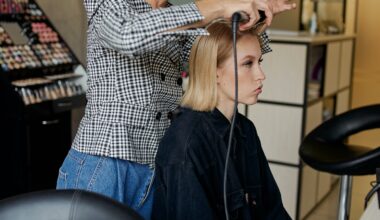Introduction: Are Hair Oils Good for Low Porosity Hair?
Hair, like skin, has its own unique texture and type. One of the most under-discussed but vital characteristics of hair is its ‘porosity’ – a term that many might not be familiar with, but is crucial when determining which hair products will work best for you. Porosity influences how your hair absorbs and retains moisture, including how it interacts with hair oils. Are hair oils beneficial for those with low porosity hair? Can they really enhance thickness? This guide dives deep into these questions, leading you through a journey of discovering the optimal hair oils tailored specifically for low porosity hair and achieving that lustrous thickness you’ve always desired.
Key Takeaways:
- The importance of understanding hair porosity and its role in product absorption.
- The unique challenges faced by individuals with low porosity hair.
- The transformative benefits of specific hair oils for low porosity hair.
- Tips and techniques for selecting and applying the perfect hair oil to boost thickness.
Understanding Hair Porosity: What It Means for Your Hair (Hair Oils According to Hair Porosity)
Hair porosity is essentially a measure of your hair’s ability to absorb and retain moisture. It’s influenced by the hair’s cuticle, which can be likened to shingles on a roof. These cuticles either lie flat, are slightly raised, or are widely spaced out, determining your hair’s porosity level: low, medium, or high.
- Low Porosity Hair: With cuticles tightly packed together, moisture and oils have a hard time getting in or out. It can often look shiny but feels dry to the touch.
- Medium Porosity Hair: This hair type strikes a balance, with cuticles that are slightly raised. It tends to maintain styles and moisture relatively well.
- High Porosity Hair: Here, the cuticles are spaced out and raised, which means while it can absorb a lot of moisture and oils, it can lose them just as quickly.
Knowing your hair’s porosity is crucial, as it directly impacts how well products, including oils, will be absorbed and provide their benefits.
The Challenge of Low Porosity Hair: What You Need to Know (Hair Oils for Low Porosity)
Low porosity hair might seem like a dream due to its often sleek and shiny appearance, but beneath that sheen lies a unique set of challenges. With cuticles that are closely packed together, this hair type tends to repel water and other hair products, making it tough for them to penetrate.
Issues Associated with Low Porosity Hair:
- Product Buildup: Since products sit on the hair rather than getting absorbed, it can lead to heavy residues and buildups.
- Dryness: Despite appearing shiny, low porosity hair often feels dry. It struggles to retain moisture, making it prone to breakage.
- Limited Benefits from Products: Standard hair products might not deliver the promised benefits as they fail to penetrate the hair shaft.
Understanding these challenges is the first step towards combating them. Armed with the right knowledge and the right hair oils, you can turn these challenges into mere bumps on the road to luscious, thick hair.
The Magic of Hair Oils: Nourishing Low Porosity Hair (Which Hair Oil is Best for Thickness)
While low porosity hair poses challenges, it’s not all doom and gloom. The world of hair oils offers a trove of treasures that can help nourish, moisturize, and yes, thicken low porosity locks. But how do they work?
Hair oils, especially those tailored for low porosity hair, are designed to have smaller molecules. This allows them to slip through the tight cuticles, providing nourishment from within. Moreover, they form a protective layer over the hair, sealing in moisture and preventing environmental damage.
When it comes to increasing thickness, certain oils stimulate the hair follicles, promoting growth, while others add volume by nourishing each hair strand from within. It’s a combination of nature and science, working in harmony to elevate the health and appearance of your hair.
Best Hair Oils for Low Porosity Hair: Top Picks and Their Benefits (Hair Oils Good for Low Porosity Hair)
Navigating the maze of hair oils can be overwhelming. But fret not, for I’ve delved deep into my two decades of hair styling expertise to bring you the crème de la crème of oils for low porosity hair:
- Argan Oil: Often referred to as ‘liquid gold’, argan oil is rich in fatty acids and vitamin E. It not only moisturizes but also protects against heat and environmental damage.
- Jojoba Oil: Its molecular structure closely resembles our scalp’s natural sebum, making it an excellent choice for low porosity hair. It hydrates without weighing the hair down.
- Grapeseed Oil: Light in texture, grapeseed oil is a powerhouse of antioxidants. It can protect, moisturize, and even aid in hair growth.
- Baobab Oil: Packed with vitamins A, D, E, and F, baobab oil is a treat for dry, low porosity hair. It moisturizes deeply and aids in hair elasticity, preventing breakages.
These oils, when chosen wisely and applied correctly, can make a world of difference. But how do you pick the right one?
How to Choose the Right Hair Oil for Your Hair Porosity and Thickness Goals (What Hair Oils are Good for Low Porosity Hair)
Selecting the perfect hair oil is akin to matchmaking; it’s about finding that compatible partner that resonates with your hair’s needs and complements its nature. For low porosity hair, this selection becomes all the more crucial. Here’s a guide to making an informed choice:
- Know Your Goals: Do you want to add shine, reduce dryness, stimulate growth, or all of the above? Identifying your primary goal can narrow down your oil options.
- Research the Oils: As we explored earlier, each oil has its unique properties. Ensure the oil you choose aligns with your hair goals.
- Consistency Matters: Lighter oils like grapeseed and jojoba are more easily absorbed by low porosity hair, while thicker oils may cause buildup.
- Porosity Test at Home: An easy way to check your hair’s porosity is the water test. Place a strand of clean hair in a bowl of water. If it floats, you have low porosity. If it sinks slowly, it’s medium, and if it sinks immediately, it’s high porosity.
Remember, the key lies in experimentation. What works for one may not work for another. Start with smaller quantities, observe how your hair responds, and adjust accordingly.
Tips and Techniques for Using Hair Oils Effectively
Using hair oil isn’t just about slathering it on; it’s an art that, when mastered, can lead to transformative results. Here are some age-old tricks sprinkled with modern wisdom:
- Warm it Up: Heating the oil slightly can enhance its absorption. But ensure it’s warm, not hot, to prevent any scalp burns.
- Focus on Application: Start with the scalp, using your fingertips to massage the oil in circular motions. This not only ensures even distribution but also boosts circulation, promoting hair growth.
- Don’t Overdo It: A little goes a long way, especially for low porosity hair. Too much oil can lead to greasiness and buildup.
- Time It Right: While some prefer overnight oil treatments, others find 30 minutes to an hour sufficient. Find your sweet spot!
- Rinse Well: Use a mild sulfate-free shampoo to wash off the oil. This ensures no residue is left behind while retaining the oil’s benefits.
Conclusion: Hair Oils Good for Low Porosity Hair
Navigating the realm of low porosity hair might seem daunting, but with the right knowledge and tools, it transforms into an enlightening journey. Hair oils, with their myriad benefits, emerge as powerful allies in this quest. From adding that elusive shine to promoting thickness, these elixirs, when chosen and used correctly, can elevate your hair’s health and beauty. So, the next time you find yourself pondering over hair oils, remember this guide and make choices that resonate with your hair’s soul. Here’s to lustrous, thick, and enviable locks!
Additional Resources For those hungry for more knowledge, delve into these recommended reads and tutorials:
- “Hair Porosity 101: Understanding and Testing Your Hair’s Porosity.”
- “The Science Behind Hair Oils: What Works and Why?”
- “DIY Hair Masks: Using Oils to Boost Hair Health.”





